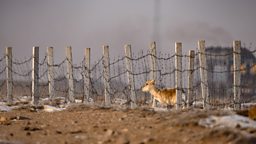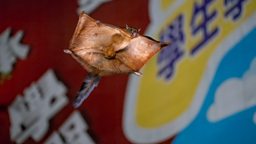The world鈥檚 rarest bear
By Nick Green, Producer

I was sat on a mountainside in the middle of Mongolia’s Gobi Desert, as the sun fell below the horizon. Below me lay a stunningly beautiful oasis, where I hoped to catch a glimpse of the majestic Gobi bear.
the Gobi bear is one of the rarest animals on Earth
This was my second year of attempting to film them, and although my team had managed to gather footage of bears using remote cameras, none of us had actually seen one of the creatures with our own eyes. And that’s hardly surprising: the Gobi bear is one of the rarest animals on Earth – with only around thirty left, spread across an area of over half a million square miles.
As the hours ticked by, sunset gave way to twilight and my eyes began to struggle in the gloom. I was about to give up and head back to camp when a ghostly figure caught my eye; not a bear, but a Mongolian wolf, coming to the oasis to get a drink under the cover of night. I watched as it vanished into the long grass and reflected on the fact that I may not have seen a bear, but the wolf was an amazing sighting in its own right.

Suddenly, the silence of the desert was pierced by a strange sound. It seemed the wolf had disturbed something down by the waterhole. I waited with bated breath to discover what the mystery animal could be and then, my heart soared, as out of the shadows emerged a Gobi bear.
...out of the shadows emerged a Gobi bear.
This was one of those ‘pinch-me’ moments that we are so fortunate to experience as wildlife filmmakers. To be in the presence of such a rare and magnificent animal was an enormous privilege, and a moment that will live with me for the rest of my life.
With my heart racing, I hurried down the hill to our camp to fetch the rest of the team. Our filming expeditions were entirely reliant on the knowledge of local experts: the Mongolians that had put us in this position are the most amazing people. We had partnered with scientist Dr Odko Tumendemberel, who has been studying the bears for fifteen years. Her research uses genetics to calculate the size of the existing population, a vital piece of information when the numbers are this low. (Her work features in the Asia On Location film at the end of The Arid Heart.)

Odko was critical in helping us select the locations for our remote cameras, as was national park biologist Nassa. His knowledge of the Gobi bears, and all the wildlife in the desert, is second to none, and his team of rangers work tirelessly to protect the bear from poaching and habitat loss. Nassa was with us on all our shoots and was central to the success of the filming, he has the sharpest wildlife-spotting eyes of anybody I’ve ever met, and he also happens to be a fantastic singer, singing beautiful traditional Mongolian folk songs around the fire in the evenings.
...it鈥檚 thought that only eight of the remaining Gobi bears are female...
Nassa also told us ancient tales about a mythical beast that roamed the desert, a somewhat human-like creature that the Mongolians called Alma, their version of the Yeti or Bigfoot. This mythical beast turned out to be the Gobi bear: rumours of its existence were only confirmed in 1943, a testament to how remote and tough a place the Gobi Desert is, and how exceptionally rare the bears are.
As the team gathered on the vantage point high above the oasis, we realised that there wasn’t just one bear below us, but two. Nassa told us this was a mating pair, which was simply astonishing. It’s thought that only eight of the remaining Gobi bears are female: they are the rarest of the rare. As the pair wandered off together, it was extraordinary to think that we may have witnessed a key moment in the future of the species, a special moment that, in time, could produce the most precious of cubs.

Gobi bears are hardy creatures, they have managed to cling to existence in one of the most extreme environments on the planet. But with their numbers so desperately low, their future rests on a knife-edge. They face threats from increasing temperatures that have caused punishing droughts, and even in this most remote of places, mining activities threaten to destroy precious habitat.
...their future rests on a knife-edge.
The future for these bears is indeed an uncertain one, with their survival resting on just a handful of individuals. But thanks to passionate and dedicated Mongolians such as Odko, Nassa, and many others that we met whilst making the series, there is still a chance that this most remarkable of species might be saved.

The world's loneliest bear
A bear cub represents hope for Mongolia's critically endangered Gobi bear.



































